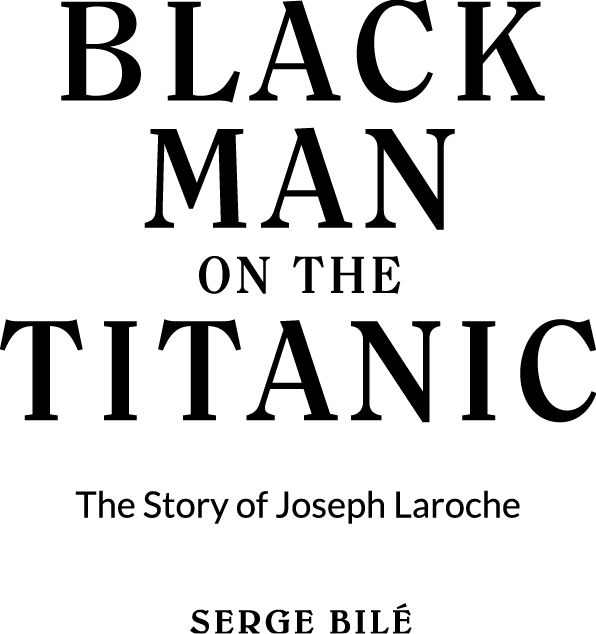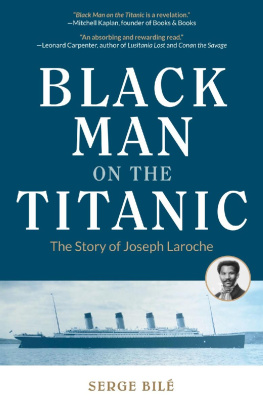
Als o by Serge Bil
Noirs dans les c amps nazis
La legende du sexe surdimensionne des Noirs
Sur le dos des hi ppopotames
Tiwa et la pie rre miroir
Quand les Noirs avaient des escla ves blancs
Le miracle oublie: chronique des apparitions de la Vierge Marie en Martinique
Et si Dieu naimait pas les Noirs? Enquete sur le racisme aujourdhui au Vatican
Au secours, le prof est noir! Enquete sur le racisme dans lEducation nationale (with Mathieu Me ranville)
Blanchissez-moi tous c es negres
Sombres Bourreaux: collabos africains, antillais, guyanais, reunionnais et noirs americains, dans la Deuxieme Guerr e mondiale
La Mauresse de Moret: La religieuse au sang bleu
Singe, les dangers de la bananisation des esprits (with Audif ac Ignace)

Mango Publishing
Coral Gables , FL

Copyright 2019 Serge Bil
Published by Mango Publishing Group, a division of Mango Media Inc.
Cover Design: Morgane Leoni
Layout & Design: Morgane Leoni
Mango is an active supporter of authors rights to free speech and artistic expression in their books. The purpose of copyright is to encourage authors to produce exceptional works that enrich our culture and our open society.
Uploading or distributing photos, scans or any content from this book without prior permission is theft of the authors intellectual property. Please honor the authors work as you would your own. Thank you in advance for respecting our authors rights.
For permission requests, please contact the publisher at:
Mango Publishing Group
2850 S Douglas Road, 2nd Floor
Coral Gables, FL 33134 USA
For special orders, quantity sales, course adoptions and corporate sales, please email the publisher at or +1.800.509.4887.
Black Man on the Titanic: The Story of Joseph Laroche
Library of Congress Cataloging-in-Publication number: 2019932090
ISBN: (print) 978-1-63353-958-7, (ebook) 978-1-63353-959-4
BISAC category code HIS056000HISTORY / African American
Translated from French by: Logan Masterworks, Miami, FL
Printed in the United States of America
Contents
The sinking of the Titanic in April 1912 generated within a century a multitude of books, films, and video games. Each of these honed in on the drama of the accident in all its forms, focusing mostly on the personality and the psychology of many of the passengers. But the tragic story of Joseph Philippe Lemercier Laroche has been largely excluded fro m history.
At a time of heightened racial imbalance and hostility, a Black man from Haiti boarded the RMS Titanic not as a crew member, but as a paying passenger: one of the few Black passengers on board the famous ship. Raised in a world of stultifying expectations about race, Joseph Laroche was educated in France, where he found professional successes and contributed to the construction of the Parisian railway. What do we know about Laroche, a direct relative of Jean-Jacques Dessalines, the first ruler of independent Haiti? How was his childhood in Cap-Hatien, and how did he come to travel to Beauvais, Lille, and Paris? Why did he give up first-class tickets for the luxury ship La France to board the Titanic with his wife and two daughters? Where was he goin gand why?
That is the story I tell: the true story of one black man whose triumphs were shadowed by prejudice, social expectations, and tragedy, but also the remarkable story of a time period. As I delve into black history and the singular bonds between the United States and the Antilles, this is definitely not just another book about the Titanic. While The Black Man on the Titanic covers the tragedy, offering a new approach to a slice of history that still fascinates millions, it also presents little-known aspects of the African American and Caribbean e xperience.
In order to properly honor Joseph Laroches story, I used a narrative style throughout much of this book, combining source material from letters, interviews, newspapers, and archives to create a more engaging n arrative.
Because I relied on testimonials and secondary sources and, as we all know, human memory is deeply flawed, some events have been compressed and some conversations and inner dialogue have been recreated in varying degrees. I retold them in a way that evokes the feeling and meaning of what was said and, in all instances, the essence of the dialogue (both internal and external) is accurate. Any mistakes are mine.
I would like to thank the descendants of the family portrayed in this book for the privilege of interviewing them, particularly Christina Schutt, the great-grandniece of Joseph Laroche, who not only provided letters and other written materials, but also shared her familys ora l history.
Thank you to Georges Michel, Christian Boutillier, and Bruno Rousseau. All the interviewees are good, hard-working people who helped with my research immensely. Christian Boutillier shared with me a file that documented everyday life at cole du Saint-Esprit in Beauvais, which allowed me to recreate the time Joseph Laroche spent at the school, although nothing in the file directly referred to Laroche himself. Bruno Rousseau, who attended the same Jesuit school I did, forty years ago in France, helped me remember the details of boarding school life: the masses, the studies, the games Our conversations revived my own memories and helped me walk in Joseph Laroch es shoes.
I was given access to a variety of written sources thanks to Franois Codet of the French Titanic Society, Father Roger Tabard of the Congregation of the Holy Spirit, and Myriam Sylvain, who generously introduced me to Gatan Mentor from the Haitian Historica l Society.
The French Titanic Society gave me access to its archives, where I found various newspaper articles from France and Canada focused on the tragedy experienced by the family of Josep h Laroche.
Father Roger Tabard allowed me to consult the archives of Congrgation du Saint-Esprit and gather the information needed to write about the functioning of the school attended by Joseph Laroche: the roles of the priests, of the administration, of the teachers. I didnt find much about Joseph Laroche himself, besides the eulogy I mention in the book, but the wealth of information allowed for a more detaile d account.
While writing The Black Man on the Titanic, I have occasionally added my personal spin to the story, mostly to fill in gaps as best I could, but I have done my best to make it a truth ful story.
Serge Bil
Cherbourg, April 19, 1996. An elderly woman is clutching a small black purse in her lap. The purse is black, as is the long coat she is wearing this afternoon. Black is appropriate, because she is still in mourning, eighty-four years after the sinking of the Titanic . Sitting on an iron chair, alone, under the gaze of a sympathetic crowd, she has just unveiled a plaque in memory of the 281 passengers who boarded the famous ocean liner during its stopover in Normandy. The plaque, covered with a blue cloth, is affixed to a headstone made of granite and shaped like a menhir, pointing towar d the sky.
Not a word, not a movement. The woman is silent. She seems frozen, both submerged and crushed by emotion. Her face is contorted, but no tears stream down her cheeks. Her lips shape into a scream, but no sound escapes.
Eighty-four years ago, Louise Laroche was on this same dock, at Ancie n-Arsenal.
Next page













